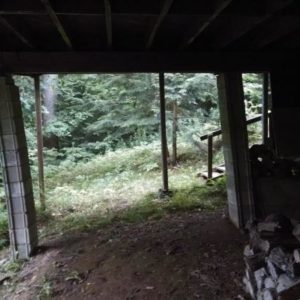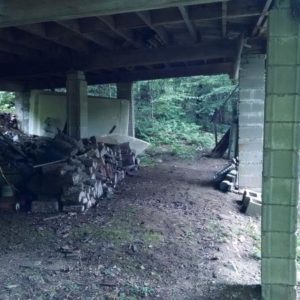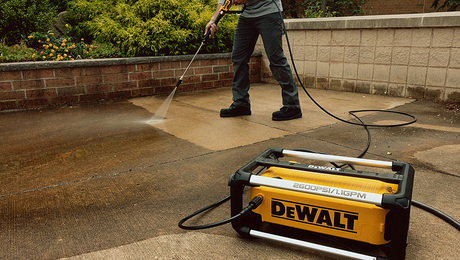Adding supports to cottage leaning on its stilts
Hello! I would be grateful for some advice on how to proceed:
I recently bought a 22×24 ft cottage built on 9 cement piers. I’m told that the piers go 4ft into the ground and are filled with rebar & cement. Unfortunately, until recently there was a wall of earth pressing against the 3 rear supports, and over time this caused the whole cottage to be pushed forward several inches, as seen below. The earth has been removed from the rear supports, and the supports seem quite strong, but I want to take steps to ensure that the cottage does not collapse, especially for the front supports pictured below since they are the longest.
I know I should get contractors in to raise the house and build brand new supports / possibly a new footing, but it’s simply not in my budget. Whatever happens needs to be done by myself and a few others with only minimal experience. Our ideas:
– Install an “X” made out of 6×6 or 8×8 posts in between the two posts below. We will dig down 4 feet and rest the posts on the footing of the existing piers, and then screw the other ends into the beams right next to the tops of the piers. The hope is that this will add more support and also prevent the existing supports from leaning forward more than they already are. Do you think that will work? Another idea is to only put in 1 diagonal support instead of 2 (from the bottom left to the top right), since it’s only forward that we need to prevent leaning.
– Beyond that, either put in some jack posts in key areas (but I’m worried that even though these will help carry the weight, they might tilt forward if the house continues to move) or build some cribs out of 6×6 hemlock timers (4 ft long per piece) and put 2 of such cribs underneath the front beams, since these will be quite sturdy and will not lean forward over time. I would be comfortable leaving them in place for several years until I have the budget to get professional work done. This could be done inaddition to the diagonal supports described above.
– Alternatively, I could replace the piers one by one with new versions (cinder blocks filled with cement and rebar), but I’m worried that it will be difficult to fill them all the way to the top since I don’t think I can jack of the cottage very much. Perhaps I could just fill them 80%, and then have the top blocks empty? Or use solid blocks for the top, or something?
Sorry, I’m an amateur with a job to do, I’d love some guidance. Thanks!





















Replies
Just to add: for the hemlock crib supports, I would build 1 long beam that runs from along the entire length of the cottage, and place it right next to the front support piers (behind them), and then support it with 2 hemlock cribs, placed in between the 3 rows of supports. It seems to me that if I did that, I would no longer need the front supports, so even if they were to fail I would be fine.
I think I'd consider mobile home anchors, driven at an angle, with corresponding straps. (Not sure how you'd get them driven, though.)
mr marbles, let me start off by saying this is just my opinion.
Have you verified if the cavities in those piers are actually solid?
I cant see how only some of the piers would lean and not all of them.
you are looking at some very alarming problems, and would not recommend attempting this yourself, based on your self assesment.
The piers pictured on your post do not look like they would have had earth up against them enough to cause them to lean the way they are leaning.
Unfortunatley your are looking at a serious undertaking that should not be taken lightly. Budget or not, i would suggest taking out a line of credit, home equity loan or something along those lines to have this issue properly addressed.
probablly not what you wanted to hear but more than likely the dreaded reality.
The house was pushed forward about 8 inches, I would guess. It was pushed from the back. But because the piers are attached to the under-structure of the house, the front piers moved with the house. One side was pushed from behind a bit more than the other side, thus the front piers on that side are leaning a bit more.
I have not verified that they are ALL filled with cement and rebar, but I think the fact that they are leaning forward and curving, *without* cracking in half, is evidence of the rebar.
At this point I've more or less settled on installing a beam underneath, supported by 2 cribs of stacked hemlock 6x6s, with some jack posts for extra support, but I would still be open to suggestions.
yikes..........
There is no way I would suggest a fix without seeing this in person which won't happen.
But I have to say I get the impression from the first pic that I wouldn't feel real cozy even walking under this structure.
Probably it isn't as flaky as all that but it almost looks like some cribbing might be in order as of right now.
Best of luck and let us know how it goes.
I would suggest that you look for a local contractor who is willing to work with you. Someone who has the knowledge that you lack is needed onsite to evaluate the situation in order to come up with a solution. You've got a hazardous condition there. Don't expose yourself nor especially your buddies to this danger unnecessarily.
Russian Roulette
Whaddaya draw straws to see who gets to fetch the firewood in the winter?
If I lost I'd fetch that wood with a rope and a grab hook tossed from daylight.
Those arent piers.
I'm not an engineer. But anyway, I'm sure there is a relationship of the height of a PILLAR to its cross sectional area, and yours look undersized by at least 75%. Also you need some type of lateral bracing to stop movement of the building. Piles will accomplish that, but a skinny stack of blocks wont. Is the building anchored to earth? High winds could blow it over easily if not.
The building needs stabilized immediately, lots of cribbing etc before any work could be safely started.
My suggestion would be to dig a professionally designed continuous foundation, and build shear or block walls to properly hold the building to earth.
Alternatively, steel beams and posts would work, but that would not likely be a diy job.
One could attempt to install diagonal braces from the downhill edge of the structure running down the hill, as a temporary measure. But the hill appears to be so steep that the braces would need to be 20 feet long, and creating a decent footing on that slope would be difficult.
One would
DanH wrote:
One could attempt to install diagonal braces from the downhill edge of the structure running down the hill...
That one person would only be you, Dan.
suggestions...
hi
First, I agree with others. I would not want to spend much time under that house on a windy or snow covered roof sort of day. And, shoring up one side does not do much with the other (see see-saw in your imagination).
At a bare minimum - provide cribbing under 4 points to share the load for the WHOLE house. not just one side or one set of piers. but to be honest, stacking Jinga blocks under the house is going to cost - what, a thousand in wood - it looks all of 8' under the house, so if you use 6" PT or rail road ties... 8' length cut in half. is 4' sections. two per foot (ignorning nominal dimensions, just under 6" each) is one 8' per foot or 8 each sticks for each of a minimum of 4 jinga block towers... assuming you dont need a cross beam at the top and you can set these jinga block towers up under carrying beams... just looking at lowes, they are $25 a stick. x 8 x 4 plus some spare.. is $200 a post. or about $1,000 for all the wood necessary. at a very very minimum, I would use 3/4 plywood as a base. it would not only spread the load a tiny bit, but it would help keep the jinga blocks from settling as fast. dig out a flat section of ground. lay a little gravel base too. to make it flat.. keeping the jinga blocks plumb and level would be a really good idea. too. ;)
Similarly, if you went with jack posts (as a TEMPORARY fix), you would probably want a minimum of 6-8 (two rows of 3 or 4, depending upon how much weight is above that but they are $65 at Home Depot... add a "footing" to support it (below the frost line sonatube in 8" would take a while to install.. .but would be worth it as they would be solid footings if you use the proper cement and dig the hole deep enough (think about renting a post hole digger!) again determining where the load beams are and if you could get away wiht one under each of the four sides and 2 or 4 x'ed in the middle... four only on outside (like with the jinga blocks) would be a bare minimum.
say $10 for each Sonotube post and $40 for cement in each.. $50x 8 is $400 for cement footing and 8 x 70ish for the columns is $600 and the post hole digger a couple hundred.. (if you found somene with a auger on a small cat, if not the gas powered two man digger would be a [CUTE LITTLE PUPPY], but only $100 from local rental center).
depending upon the soil and depth, you could consider helical piers for footings but that is going to cost a ton more. Probably, $1,000 for the crew for the day and they could easily set 8, then you need cement caps and the columns on top of that. the Sonotubes method would probably suffice for now, but the helicals would be belts and suspenders.
Trying to stop the movement is silly. the house is on a hill and cross beams wont do a hill of beans if the house wanted to move farther down hill. Trust me on that one. That part is simple. Neither is using mobile home straps or anchors going to prevent it from slipping further into the oblivion. Keeping the whole structure from falling down/to the ground is the only logical interim solution. Think about it... you say to "prevent leaning" ... Really? do you think you can prevent leaning on that hillside?
lastly, I am not a Civil engineer and my comments are not advice but a freel flowing discussion as to what I might consider if I had all the facts, a soil engineer test, an A2 survey and a whole boat load of insurance :)
Good luck! Patrick
and for [JOBSITE WORD]s and giggles, google map - street view
427 cosey beach avenue extension east haven ct
they originally built that house on what appears to be insufficient footings (depth and breadth from what I understand) and it is now supported by the block cribbing you inquired about. The scuttlebut in the 'hood is that the town required the blocks or they were going to condemn it as unlivable.
you might want to check with your local building inspector. He might be able to give you some good ideas, but be prepared to not sleep in the house until you remediate the danger - which given the two pix is clear and present and should be addressed at your earliest possible convenience.
To keep it from sliding further downhill, it might be feasible to bury deadmen about 50 feet uphill and install cables from them to the floor framing. Would be far from a permanent fix, but might buy some time.
And one thing that should probably be done in any event is to study the points where those "piers" mate with the framing and do whatever you can to keep the tops of the piers from sliding out from under their support points. From the looks of things it wouldn't take much for a pier to pop out.
First, you need to hire an engineer!!!
You haven't posted what part of the country you are from...big concern in snow areas because large snow load could double all the other loads of the house combined. Or earthquake zones. Or wind exposures. Or exposrures to flood waters? All of these are significant exterior forces on a structure...
This 'foundation' (use the term loosely) has very limited lateral support and has failed. You would want to discuss solutions with the engineer.
Regarding using hemlock timber cribs - hemlock is susceptible to rot and cribbing is not a very effecient way to resist the lateral forces you are dealing with.
If I were in a meeting with your engineer, I would want to discuss a system of new footings, treated wood columns and diagonal supports. The diagonal supports are critical to transfer the lateral stress from the house structrure to the foundations. I would look at the existing concrete columns as temporary support for the new system. This way, the existing columns could be left in place until the new footings and supports are installed. Another option would be to replace the existing columns one at a tine. You would have to temporarily reinforce the house at this point, install the new support and then remove the temporary measures.
You should also consider some temporary lateral support now to protect you while working under this structure.
Hmm?
I am not an engineer, but......
If teh building is totally freestanding, in other words not physically tocuhing teh ground, then I would think building new support columns next to each leaning column would do the trick. Proper sized footing and proper width columns. I think the current columns are so small, particularly if earth were at on time unilaterally piled against some but niot all of teh columns.
It might be a bit nerve racking to work under there, but if you crib the building up first, it would be doable.
I also think a structural engineer could review this situation at size teh columns for you for not too much money. the actual fix, if you do the work, would not cost too much.